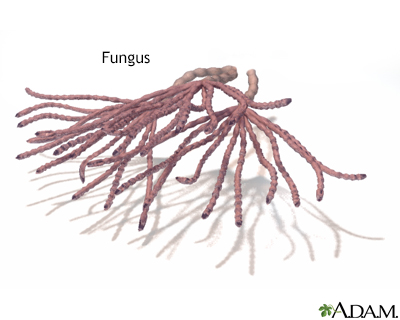Mucormycosis
Fungal infection - mucormycosis; Zygomycosis
Mucormycosis is a fungal infection of the sinuses, brain, or lungs. It occurs in some people with a weakened immune system.

Fungal infections are caused by microscopic organisms (fungi) that can live on the skin. They can live on the dead tissues of the hair, nails, and outer skin layers.
Causes
Mucormycosis is caused by different kinds of fungi often found in decaying organic matter. These include spoiled bread, fruit, and vegetables, as well as soil and compost piles. Most people come in contact with the fungus in the environment.
People with a weakened immune system are more likely to develop mucormycosis. These include people with any of the following conditions:
- AIDS
- Burns
- Diabetes (usually poorly controlled)
- Leukemia and lymphoma
- Long-term steroid use
- Metabolic acidosis
- Poor nutrition (malnutrition)
- Use of some medicines that suppress the immune system
Mucormycosis may involve:
- A sinus and brain infection called rhinocerebral infection: It may start as a sinus infection, and then lead to the swelling of the nerves that come from the brain. It may also cause blood clots that block vessels to the brain.
- A lung infection called pulmonary mucormycosis: Pneumonia that gets worse quickly and may spread to the chest cavity, heart, and brain.
- Other parts of the body: Mucormycosis of the gastrointestinal tract, skin, and kidneys.
Symptoms
Symptoms of rhinocerebral mucormycosis include:
- Eyes that swell and stick out (protrude)
- Dark scabbing in nasal cavities
- Fever
- Headache
- Mental status changes
- Redness of skin above sinuses
- Sinus pain or congestion
Symptoms of lung (pulmonary) mucormycosis include:
- Cough
- Coughing blood (occasionally)
- Fever
- Shortness of breath
Symptoms of gastrointestinal mucormycosis include:
- Abdominal pain
- Blood in the stools
- Diarrhea
- Vomiting blood
Symptoms of kidney (renal) mucormycosis include:
- Fever
- Pain in the upper abdomen or flank
Symptoms of skin (cutaneous) mucormycosis include a single, sometimes painful, hardened area of skin that may have a blackened center.
Exams and Tests
Your health care provider will examine you. See an ear-nose-throat (ENT) specialist if you are having sinus problems.
Testing depends on your symptoms, but may include these imaging tests:
A biopsy must be done to diagnose mucormycosis. A biopsy is the removal of a small piece of tissue for lab examination to identify the fungus and invasion into host tissue.
Treatment
Surgery should be done right away to remove all dead and infected tissues. Surgery can lead to disfiguration because it may involve removal of the palate, parts of the nose, or parts of the eye. But, without such aggressive surgery, chances of survival are greatly decreased.
You will also receive antifungal medicine, usually amphotericin B, through a vein. After the infection is under control, you may be switched to a different medicine such as posaconazole or isavuconazole.
If you have diabetes, it will be important to get your blood sugar in the normal range.
Outlook (Prognosis)
Mucormycosis has a very high death rate, even when aggressive surgery is done. The risk of death depends on the area of the body involved and your overall health.
Possible Complications
These complications may occur:
- Blindness (if the optic nerve is involved)
- Clotting or blockage of brain or lung blood vessels
- Death
- Nerve damage
When to Contact a Medical Professional
People with weakened immune systems and immune disorders (including diabetes) should seek medical attention if they develop:
- Fever
- Headache
- Sinus pain
- Eye swelling
- Any of the other symptoms listed above
Prevention
Because the fungi that cause mucormycosis are widespread, the best way to prevent this infection is to improve control of the illnesses associated with mucormycosis.
References
Centers for Disease Control and Prevention website. Mucormycosis. Mucormycosis basics.
Kontoyiannis DP, Ostrosky-Zeichner L. Mucormycosis. In: Goldman L, Cooney KA, eds. Goldman-Cecil Medicine. 27th ed. Philadelphia, PA: Elsevier; 2024:chap 312.
Kontoyiannis DP, Lewis RE. Agents of mucormycosis and entomophthoramycosis. In: Bennett JE, Dolin R, Blaser MJ, eds. Mandell, Douglas, and Bennett's Principles and Practice of Infectious Diseases. 9th ed. Philadelphia, PA: Elsevier; 2020:chap 258
Version Info
Last reviewed on: 11/10/2024
Reviewed by: Jatin M. Vyas, MD, PhD, Professor in Medicine, Harvard Medical School; Associate in Medicine, Division of Infectious Disease, Department of Medicine, Massachusetts General Hospital, Boston, MA. Also reviewed by David C. Dugdale, MD, Medical Director, Brenda Conaway, Editorial Director, and the A.D.A.M. Editorial team.
